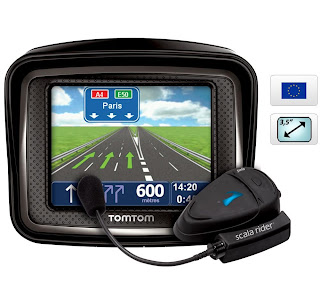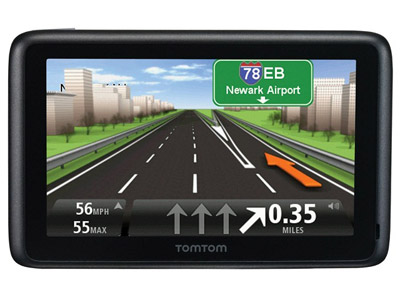TomTom Rider Pro GPS - waterproof GPS unit with touchscreen, 3.5" glove-friendly touch screen, improved glove-friendly screen for easier and safer navigation.The display screen of the unit, though fairly small (3.5 inch, 320x240 pixel), is very clear and manages to pack a lot of information within its frame.The display also packs in current speed versus the speed limit (highlighted in red when exceeded), eta, distance, and time to final destination, phone and headset status and the all important battery status.The main menu has just two simple buttons 'Navigate to' and 'Browse map', so you can get going without any hassle.

Clearly shows which lane to take at junctions so you don’t miss your turning. On the most difficult highway intersections, realistic 3D representation of the junction keeps you relaxed and safe. An impressive feature is the extremely clear lane guidance it gives especially on motorways.Although I’m a regular up there it still requires concentration and planning to get into the right lanes yet the TomTom highlights which lanes you need to be in as it expands the display to concentrate on the junction only. Once the junction has been negotiated it returns to the normal distance view, and the whole thing works seamlessly.
Only TomTom uses actual speed data collected from millions of users to calculate the fastest routes at any point in time. Imagine a route that takes into account rush hour, traffic lights, zebra crossings, school exits or even shopping crowds, every minute of every day.The display also packs in current speed versus the speed limit (highlighted in red when exceeded), eta, distance, and time to final destination, phone and headset status and the all important battery status.
You get a ‘U’ bracket to clamp around something – usually your handlebar or in my case the windscreen brace (the benefits of an old bike). Both long and short stemmed ball sockets are supplied, the short one I’ve got permanently attached and used it again. The long one would be needed if the unit is going to be used from the handlebars, you don’t want to be fouling the unit while reaching for levers etc.
To the ball socket is attached a double ended collar, and into this the ball from the unit cradle sits. That way you have movement at both ends of this ‘arm’ and should be able to find a comfortable viewing angle whatever bike you’ve mounted it to. Tighten the arm up and it clamps both ball sockets, and away you go.
Start driving with the latest map - guaranteed! If a new map for your device is available within 30 days of first use, you can download that map once for free via TomTom HOME, please note you are only entitled to one free map download. Due to the continuous improvements in our map quality, some new maps may not fit on your device. In these cases, detailed Map Zones are offered for download. You can only use one Map Zone on your device at a time but it's easy and free to change to another zone at any time using TomTom.
Your device comes with fixed speed camera alerts pre-installed, to help you to drive more safely and responsibly, while saving money on speeding fines.The final thing I was able to test was the speed camera alert system. Since I hadn’t studied the reference book I was somewhat taken aback by the level of detail in which the speed cameras are notified. All the current types of camera have their own symbols and noises, including the average ones which don’t work on bikes as they face forward – I would disable these to be honest. Which is a shame because you are warned on approach, when entering the zone, while in the zone (aural if speeding), and at the end of the zone. All very clever but on a bike, in this country, we don’t need warning of average speed cameras.

Cardo wireless headset includes: Cardo scala-rider Bluetooth headset - receive clear voice instructions, and receive phone calls easily, through wireless technology.The Rider Pro set does indeed come with one of Cardo Systems Scala headsets so the unit doesn’t have to bellow directions at you like a crazy person, which would be pretty startling for passers as a voice. I was a little sceptical I will admit, sceptical about how I’m going to make myself heard at 80mph in a full face lid but more of this later.Also in the box were a couple of bags of bolts and brackets for fixing the unit to the bike, plus the Scala microphone and of course the actual TomTom Rider itself and you can also listen to music this way too directly via the Scala Rider headset (not the TomTom).
The Cardo Scala-Rider headset is state-of-the-art Bluetooth enabled, completely waterproof and apparently easily mounted in the helmet. With that marketing guff in my head I set about my beloved Xlite, and a few minutes later I’d attached the mounting plate (with microphone attached) to the side of the lid, a small cut being needed in the plastic collar on the neck padding, and I’d run the very thin speakers through the lining and velcro’d them into position. The main guts of the Scala-Rider is a waterproof rubberised ‘pod’ which clips over the fixed plate and lives on the outside of the helmet where you have the on/off and volume controls.I tried the helmet on and it was no bother. I could feel one of the speakers against an ear but it was far from uncomfortable and something I’d spend more time fiddling with if I was keeping the unit.

It would appear so although there is a battery cable available on the TomTom website for the princely sum of £6.84. Why it isn’t included is a mystery to me, no matter how good the battery is on the Rider it will only get worse through use and not everyone will remember to recharge the unit after use, plus it surely means taking a charger with you for overnights etc? In its defence the mains charger is basically a USB cable and a small plug unit so it’s dual purpose and indeed I suspect could be charged off a computer if you forego the wall plug adaptor.
TomToms are supplied fully loaded before shipping so there was no CD enclosed, and any further map updates are done online via the TomTom software on the unit itself. Plug it in via the mains/USB cable mentioned and it’ll load up. Subsequent maps are a chargeable download normally, although if a new one is available within the first 30 days of you using the Rider you get it free (one only). Upgrade bundles are available – 2years costs £70 for example.
To explain fully, this is the Rider Pro (£400 per TT website) which comes with Western Europe, (except some of the Balkans) as standard. You could save some money and dispense with the headset to get the Urban Rider (£300) unit, the GPS unit on its own. Or there is the Urban Rider Regional for nigh on half the price (£250) of the Pro which has only a map of the UK on it. So you won’t need to be buying maps left and right, city by city, as the buying of maps is about keeping the unit up to date rather than, Regional unit aside, expanding its coverage.
Without bothering to download the user reference guide (the manual supplied is little more than a fitting guide in about 30 languages) I set about programming both my home address and my client’s address. It is a simple and intuitive task although I did struggle with the keyboard letters in the corner of the screen but if I’d bothered to read the online reference manual I’d have found the ‘Glove Friendly’ screen option which resizes the buttons.
My travel time was about 8hrs, and the unit came back with a shade under half its battery life intact. I was using it in the power saving mode whereby it only illuminates the display when there’s something to tell you about – a change in direction, a speed camera etc, which I don’t think is too bad at all. There won’t be many times you ride for more than 8 hours without charging opportunities, and certainly it will cope with the occasional night where it isn’t charged. Battery cable? Ok maybe it doesn’t need one right away.
If the standard display shortcuts aren’t enough for you there is a custom menu (the Quick Menu) you can control which is accessed straight from the main driving screen as the blue pointing hand. By the time I get a chance to use the unit on the bike I’m really warming to it, and can already see numerous advantages over my current system. But using it in the car is one thing, but how will it work in its proper environment on the bike? And how does the touch screen handle my big winter gloves?
I called home and once the mic was better placed Lou could hear me and despite having my ear plugs in I could hear her too! Amazing, and I was really impressed. I hate riding without plugs, albeit only cheap everyday bike-shop plugs, and really doubted I’d be able to hear the conversation. Operating the phone via the TomTom is easy although I’d advise pre-programming all numbers you want – tapping in a number while riding really isn’t on for safety reason as much as the practicality of it.
I was surprised to receive a call while en-route too, I had the TomTom set to answer automatically after 3 seconds and no sooner had I realised what the warbling in my ears was then someone was asking how I was! I will admit that at illegal motorway speeds it was difficult to hear this call and he couldn’t make out properly what I saying either. I slowed to about 50mph and it was much better but stopping was the answer.
I’m not a fan of phone calls on the move, hands free or otherwise, anything other than a social chat and too much concentration is involved. So I pulled over when it was safe to do so. Despite this advice, I would still go equipped as it is so much easier to deal with a call after pulling over than to remove helmet, gloves and plugs then dig out the phone to hear the voicemail and make a call.






















































